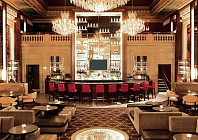Downtown Chicago evokes Gatsby and Gotham City in equal measure. Turn any corner within The Loop – the city’s beating heart – and you’d be unfazed to see billionaire-playboy Bruce Wayne cavorting in his Lamborghini, or titular-character Jay strutting between social appointments. Chicago may have its own noteworthy sons and daughters, with the likes of Oprah Winfrey, Michael Jordan and Barack Obama hailing from Chi-Town, but it seems fitting to pluck larger-than-life characters from pure fiction, because that’s what Chicago seems to be: a film set, a graphic novel, a thriller. Take your pick.
Downtown sunsets on the subway in Chicago
Perhaps one of the city’s historic residents is a better option to paint the aesthetic. Brothel bouncer, boxing promoter and bootlegger, Alphonse Gabriel “Al” Capone carved his fortune and his infamy on the shores of Lake Michigan – all the while nattily buttoned down in his three-piece suit. While the mobster shot to fame more than a century ago, the essence of Downtown has been lovingly maintained throughout subsequent decades.
Telescopic buildings have billowed upward and the city’s skyline has mixed bygone-era bastions with postmodern megaliths, but the most prevalent of all architectural styles is famously art deco. The muscular and geometric structures dramatically jut out of Downtown with all the glamour of the roaring twenties and the confidence of capitalism.
Chicago’s mobster past is easy to caricature, but fast-forward to the last gasps of 2015 and the city has evolved while maintaining both legacy and look. This is, in fact, the very birthplace of the skyscraper; where the first steel-frame skyscraper, the Home Insurance Building, was erected in 1885 – initially a dizzying 10 storeys at a height of 42 metres.
As planning regulations eased and construction technologies improved, the city lurched upward, maintaining its art deco elegance despite prevailing fads and the risk of overzealous architects trying to make a statement. Some façades may offer a juxtaposing style, such as the Adrian Smith-designed Trump International Hotel and Tower (precursor and step-brother to Dubai’s epic Burj Khalifa), but other new hotels are being packed neatly into Chicago’s existing body of work.
Room at the Inn
Classic luxury at the brand new Residence Inn Chicago Downtown/Loop
One such hotel is the Residence Inn Chicago Downtown/Loop that opened last month on South LaSelle Street, adjacent to the (surprise) quintessentially art deco Chicago Board of Trade Building, which starred as “Wayne Tower” in the caped-crusader prequel Batman Begins. Not only is the former Lumber Exchange Building one of Chicago’s newest hotels, the property arrived with a splash as the brand’s 700th local property. The chain pulled out all the stops for the celebratory bash, which also marked Residence Inn’s 40th year, the building’s 100th anniversary and was a precursor to Marriott’s imminently announced buyout of Starwood Hotels & Resorts.
While the uncanny confluence of business deals, anniversaries and arbitrary numbers won’t necessarily titillate tourists, the hotel happens to be nested in a prime position for purveying the city. The mix of studio, one-bedroom and two-bedroom suites are scattered with original details and the oversized windows peer out at the ebb and flow of the financial district.
The buzz of the working day gives way to tranquillity each night after commuters spill back on the “L” (elevated) rapid-transit train and return to the suburbs. While the hotel specialises in longer-stay clients, the cosy “inn” is surprisingly plush with rooms averaging 50 square metres or more, walk-in showers, effortless and gloriously free Wi-Fi connectivity and a lavish daily breakfast.
The hotel bar, Roanoke Lounge, borrows the building’s former name and dishes out local craft brews, signature cocktails and all the familiar staples to keep you warm through the winter. The main restaurant won’t open until March but the building is already loaded with quirks and flourishes to keep guests entertained.
Ask nicely and the staff might even escort you up to the bell tower, to see the enormous, fully functioning and alarmingly loud (pun intended) bells. Or venture deep into the basement to find the original cart tracks that would have delivered coal daily, almost a century ago. It’s easy to jibe America for its thin veneer of history, but the
entire city is rich with the uncanny synergy of stasis and progress.
Looping around town
The “Loop” included in the property’s name doesn’t quite pinpoint its location – as any Uber driver will hastily explain, rolling their eyes and imploring you must know precisely where in the sprawling Loop area you intend to be. The area takes its name from the rectangular-ish ring formed by the L, surrounding the new Residence Inn, tucked near the corner of West Madison near a cluster of stations.
All of which are just a jaunt from Millennium Park, home of the beloved mirrored-bean sculpture, officially titled “Cloud Gate”; the handiwork of Indian-born British artist Anish Kapoor. The stainless-steel blob has been one of Chicago’s utmost icons within the past decade, drawing crowds year-round and not just for novelty mirror selfies.
Even through the winter, hordes of Chicagoans and tourists alike will descend on the McCormick Tribune Ice Rink, which remains open until March 6. Beyond the rink the city has been transformed into a winter wonderland with the outdoor Christkindlmarket embracing about a million visitors at Daley Plaza until Christmas Eve. Rain, snow or shine, this coastal shoulder area offers plenty more for the culture-thirsty spendthrift.
If you’re not fully distracted by shopping for gifts and imbibing mulled wine, then take a walk past the Jay Pritzker Pavilion, Frank Gehry’s outdoor concert hall that buzzes with blues and jazz riffs throughout the summer months. Not many steps later and you’ll be treading the concrete floors of the Art Institute of Chicago (111 S Michigan Ave.; +1 312 642 6805; www.artic.edu), one of the world’s finest collections of impressionist and post-impressionist art, also littered with double-take-worthy American gems like Grant Wood’s “American Gothic” (early 1900s) and Edward Hopper’s “Nighthawks” (1942).
Upward of 1.8 million tourists visit the expansive museum each year, rubbing their chins and shuffling their feet around 92,903 square metres of building space. Remarkably, the site spans open railroad tracks via a two-storey bridge, connecting the historic shoebox building with the six-year-old Modern Wing, designed by Italian architect Renzo Piano.
The early-20th-century European art collection has the likes of Picasso and Matisse all (figuratively) hanging out in the hallways, as well as original renderings by super-starchitects Frank Lloyd Wright, Ludwig Mies van der Rohe and Bruce Goff. Even a relative luddite (such as myself) is able to pinpoint Monet’s “Water Lilies”, or “The Great Wave off Kanagawa” by Hokusai – seemingly ubiquitous at one point in every college dorm room in the form of a tattered poster. Even the impression of the original woodblock print is truly worth a glance.
Bueller… anyone?
One of the most endearing features of the artistic hub is surprisingly not a display piece. Visitors are offered the chance to augment their US$25 ticket to include a trip to Willis Tower’s iconic Skydeck and pose on glass-floored balconies on the building’s 103rd floor. This particular package could reasonably be been referred to as “the Ferris Bueller deal”, mimicking the antics of the enigmatic high school delinquent and his eventful bout of truancy in the almost-eponymous 1986 Matthew Broderick flick. All that’s left now is a twist and shout on a parade float but given the bracing winter weather, how about some music indoors?
A brisk 10-minute stroll in a 5/4 time signature will get you from the Residence Inn to the front door of Andy’s Jazz Club & Restaurant (11 E Hubbard St.; +1 312 642 6805; www.andysjazzclub.com) in River North. Better known simply as “Andy’s”, the club has been a bastion of polyphonic improv since 1951 when it began sheltering jazz hounds during the city’s newspaper-industry boom.
To this day, the turnout is solid and the crowd is intimidatingly educated. Take note; when the audience ripples with applause after a particular drum fill, double bass solo or incomprehensible arpeggio… just applaud and nod your head along with everyone else. But if you’re hoping to move more than your ankles and wrists, then hail a cab and head for Kingston Mines (2584 N Halsted St.; +1 773 477 4646; www.kingstonmines.com).
If you’ve landed in Chicago O’Hare and spent your days dawdling in Downtown, then a simple 20-minute excursion will let you get a taste of the real Midwest. The place is kicking each and every day of the year, including Thanksgiving and Christmas Day, with blues jams ringing out from two stages until 4am – without fail.
The venue, so named from a pre-existing theatre company, not-so-famously played host to the original version of Grease, where it was written and premiered in 1971 before moving to Broadway the following year. Having been owned by the same family for more than four decades, Kingston Mines is the oldest continuously operating blues club in Chicago. It also handily houses the recently renovated Doc’s Rib Joint, but you may be already be aware that Chicago is better known for a different kind of foodstuff.
When the moon hits the sky
Deep blues, deep snow and deep-dish pizza; Chicago doesn’t play by halves. Chicago-style pizza isn’t exactly a staple for the locals, despite the chillier winter months, and is undoubtedly a heart stopper if abused. It is, however, pretty much a rite of passage for visitors who want to get a taste of the city’s most iconic meal.
The pan used to bake pizza pies has to be deep enough to hold a steaming mass of cheese and rich, chunky tomato sauce. Illinoisan pizzerias, such as Lou Malnati’s (www.loumalnatis.com), are dotted around the city centre and rival the likes of Grant Achatz’s thrice-starred Alinea or, dare it be said, Michael Jordan’s Steak House at the InterContinental on the Magnificent Mile – a retail and restaurant strip to give London’s Oxford Street a run for its money.
Lou’s (also contracted to “Luminati’s”) has even raised the bar of gluttony with a Chicagoan pizza devoid of dough. That’s because the base and “crusts” are composed of sausage meat – ideal for paleo fanatics. You may even prefer to grab a lobster roll from any of the gourmet food trucks dotted around town. The meals-on-wheels options have taken the city by storm in recent years, so much so they’re barred from parking within 60.96 metres (200 feet) from a restaurant. It’s just as well Chicago is a walkable city, because hearty fare is de rigeur.
All in all, whether you’re in or out of The Loop, Chicago won’t fail to leave its mark. Way beyond its Manhattan-esque nucleus lie numerous Brooklyn-style neighbourhoods, steadily filling with gourmet destinations, concept bars and high-end thrift stores. Just last year, Soho House Chicago debuted in West Loop, an area composed of Fulton Market, Randolph Market, Jackson Boulevard and Greektown. The members-only club is geared toward the creative community and franchised from the London edition that’s existed since the early 1950s, but is apparently indicative to hipsters that the city has “arrived” – the Istanbul chapter also opened in May of this year.
Many cities are described as “dynamic”, but once you find yourself at a packed-out jazz club on a Monday night, lost for an entire day in a gallery or wearing out your soles gawking at the city’s sublime architecture, you may have to reassess your definition of what dynamism truly means – while you also redefine your definition of pizza pie.
Stay








